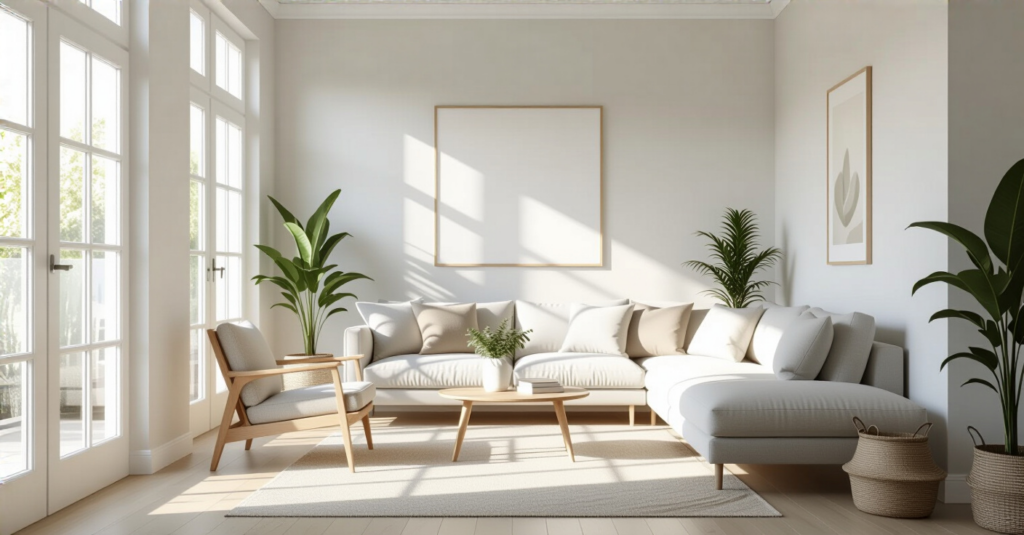You know what people always ask me? They see the restful bedrooms I create and say, “Luna, this is wonderful, but my whole apartment is a shoebox. How can I feel this calm when my living room is my office, my dining room, and my decompression zone all at once?”
And I get it. We’re taught to think about space in square feet, but what truly matters is how a room makes you feel. A cluttered, tight space keeps your nervous system on high alert. It’s a low-grade, constant stressor you might not even notice until it’s gone. The secret isn’t about magic tricks to make the room look bigger in a photo. It’s about creating a space that gives your mind room to breathe. It’s about building a sanctuary, no matter the size.
The big lie everyone tells you is that you just need to buy “apartment-sized” furniture and call it a day. That’s just noise. What really matters is visual weight, flow, and intention. I once worked with a client whose living room was technically “well-designed” with all the right small-scale pieces, but he was still anxious and sleeping terribly. We realized the room had no flow, no place for the eye to rest. It was a collection of objects, not a cohesive space. We swapped out half the ‘correct’ furniture for a few larger, calmer pieces and suddenly, the room could breathe. And so could he.
Let’s walk through how to bring that same deep, restorative calm to your living room.
Foundational Strategies: Visually Expanding Your Small Space
Before we talk about furniture or decor, we have to create a sense of spaciousness in the mind. Think of these first steps as creating a clean, quiet canvas. They are less about optical illusions and more about signaling to your brain that this is a place of peace and openness, where it’s safe to relax.
1. Harness Light Wall Colors: Create a Soothing Atmosphere
This is about so much more than making a room “look bigger.” Think about how you feel looking at a soft, endless sky versus a dense, dark forest. Light colors—like soft whites, gentle grays, or washed-out blues—are fundamentally calming to our nervous system. They reflect light, yes, but more importantly, they create a feeling of expansiveness and clean air that reduces feelings of being enclosed.
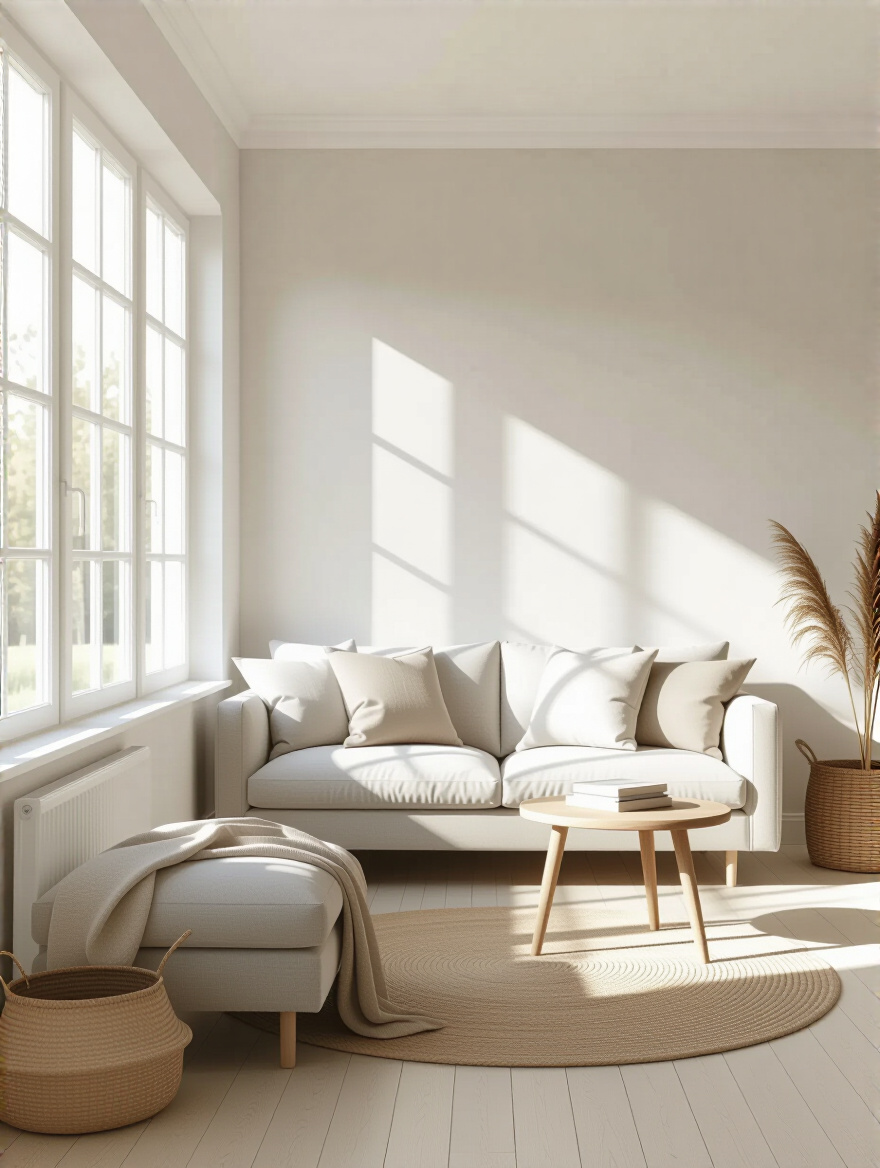
Dark, saturated colors can feel cozy in the right context, but in a small space, they can often feel heavy, like the walls are closing in. We’re aiming for a space that feels like a deep, cleansing breath. These light, airy colors act as the foundation for that feeling, providing a serene backdrop that allows both your mind and your decor to rest.
Once you’ve created this quiet backdrop, you can use reflections to gently amplify that sense of openness.
2. Strategic Mirror Placement: Gently Expand Your Sanctuary’s Boundaries
Forget the idea of “doubling your room size.” That’s a gimmick. A mirror’s real power in a small sanctuary is its ability to bounce soft light and create a sense of depth. Placing a large, simple mirror across from a window doesn’t just reflect the view; it brings the feeling of the outdoors—the light, the sky, the movement—inside. It breaks down the feeling of being in a box.
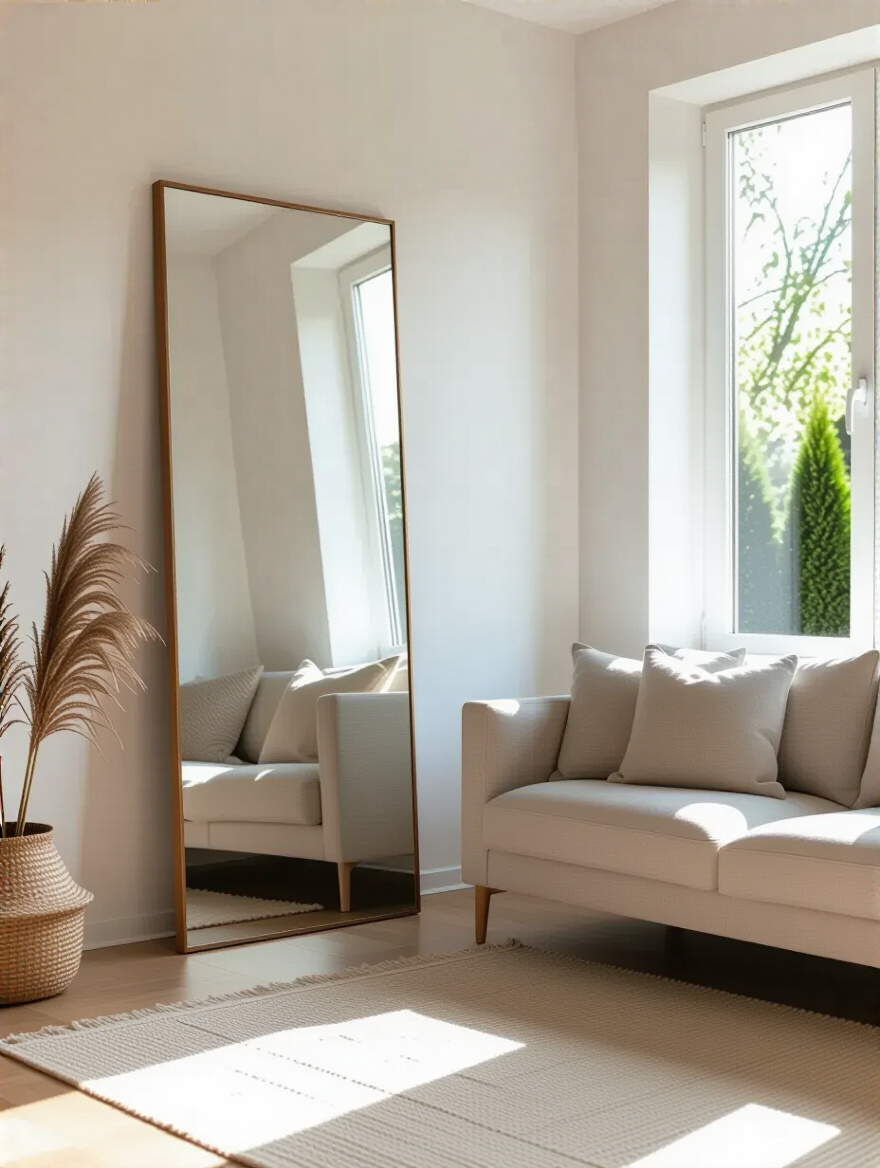
The key is to be intentional. What do you want to see more of? Place a mirror to reflect your favorite piece of art, a beautiful lamp, or the soft light from a window. This isn’t about tricking your eye; it’s about curating the experience of your space, creating gentle layers of light and peace that make your sanctuary feel boundless.
Next, we’ll look at how the furniture itself can contribute to this feeling of lightness and flow.
3. Elevate Furniture on Legs: Let Energy and Light Flow
I used to think this was just a style choice. Then I realized its profound impact on a room’s energy. Furniture that sits heavily on the floor, like a skirted sofa, can feel like an anchor, grounding the room in a way that feels dense and stagnant. It literally stops the flow of light and creates dark, heavy shadows underneath.
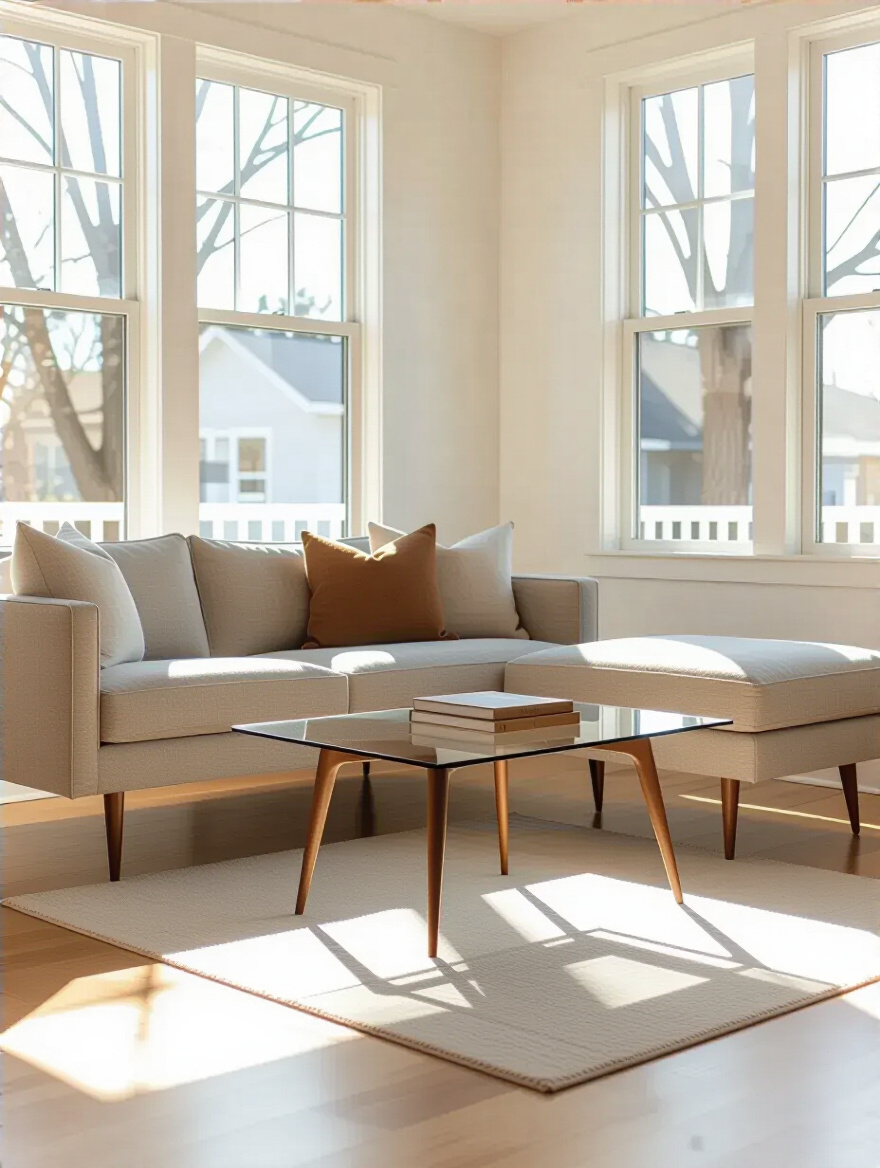
Elevating your sofa or armchairs on slender legs is like letting your room take a breath. It allows light and air to move freely, creating a sense of lightness and dynamism. Your eye can travel uninterrupted across the floor, which sends a subconscious signal of spaciousness to your brain. This single change can make a room feel less “stuck” and more alive.
With your furniture feeling lighter, let’s make sure the path through your room feels just as effortless.
4. Define Traffic Paths: Create Channels for Calm Movement
Think of the pathways through your living room as streams. If they are blocked with rocks and debris, the water gets trapped and stagnant. The same is true for the energy in your home. When you have to constantly squeeze past a coffee table or sidestep a chair, it creates tiny moments of friction and subconscious stress throughout your day.
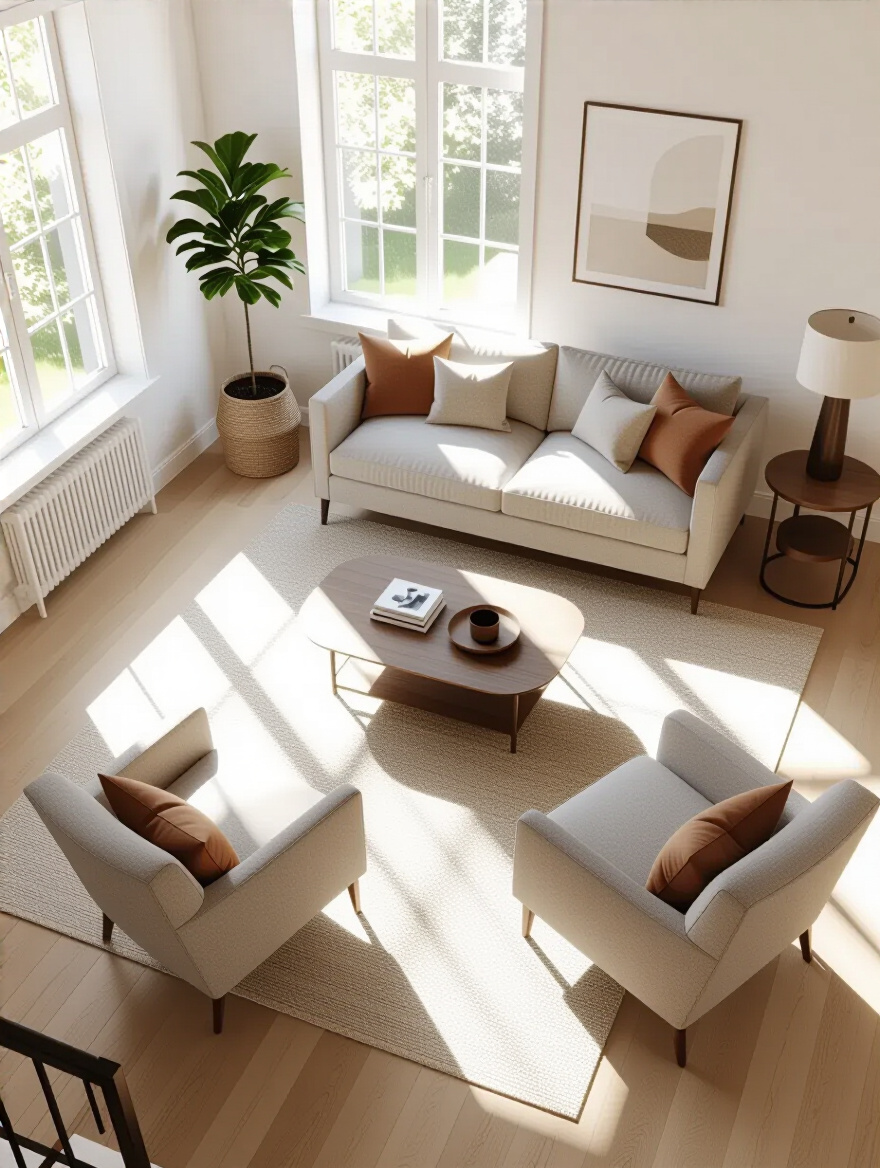
Carving out clear, generous pathways for movement isn’t just practical; it’s a form of respect for your own well-being. It creates a sense of ease and grace. A room that you can move through effortlessly is a room that feels bigger, more welcoming, and infinitely more calming. It tells your body and mind, “There is enough space for you here.”
Now that movement is easy, let’s address the biggest enemy of a restful mind.
5. Clear Visual Clutter: Give Your Mind a Place to Rest
This is the most important step of all. Visual clutter is mental clutter. Every unnecessary object on a surface is a tiny demand on your attention. A stack of mail, a tangle of cords, a collection of knick-knacks—they are all part of a visual static that prevents your brain from ever truly powering down.
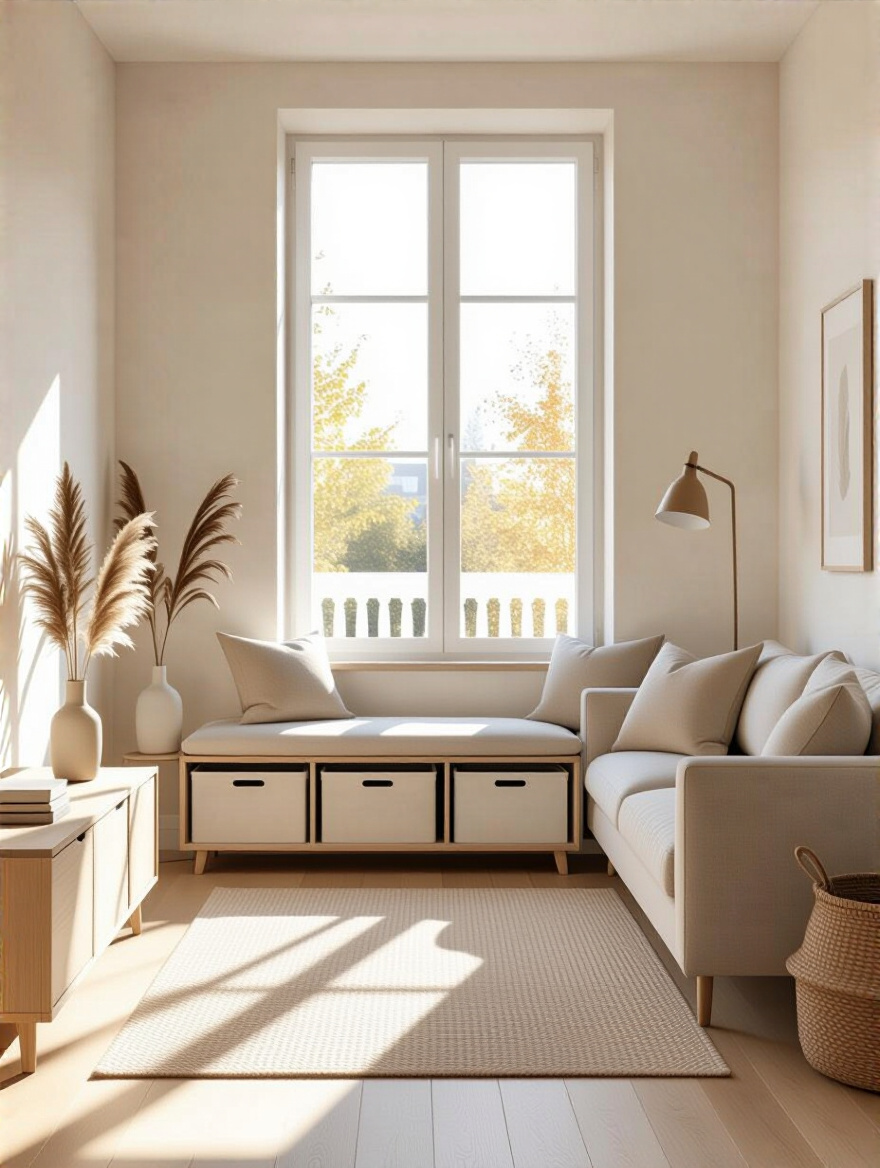
As a sleep expert, I can tell you this directly impacts your ability to rest, even if the clutter isn’t in your bedroom. Your home is a single ecosystem. Creating a calm living room gives you a vital space to decompress before you head to bed. Start by clearing every single flat surface. Then, intentionally put back only what is beautiful or essential. This act of “editing” is the most powerful way to reclaim your space and your peace.
Building on that clarity, we can use color to deepen the sense of serenity.
6. Unify Color Palette: Weave a Story of Serenity
Imagine walking into a room where ten different songs are playing at once. That’s what a room with too many competing colors can feel like to your senses. A unified color palette, on the other hand, is like a soothing, meditative hum. It creates a seamless visual experience that allows the eye—and the mind—to flow peacefully through the space.
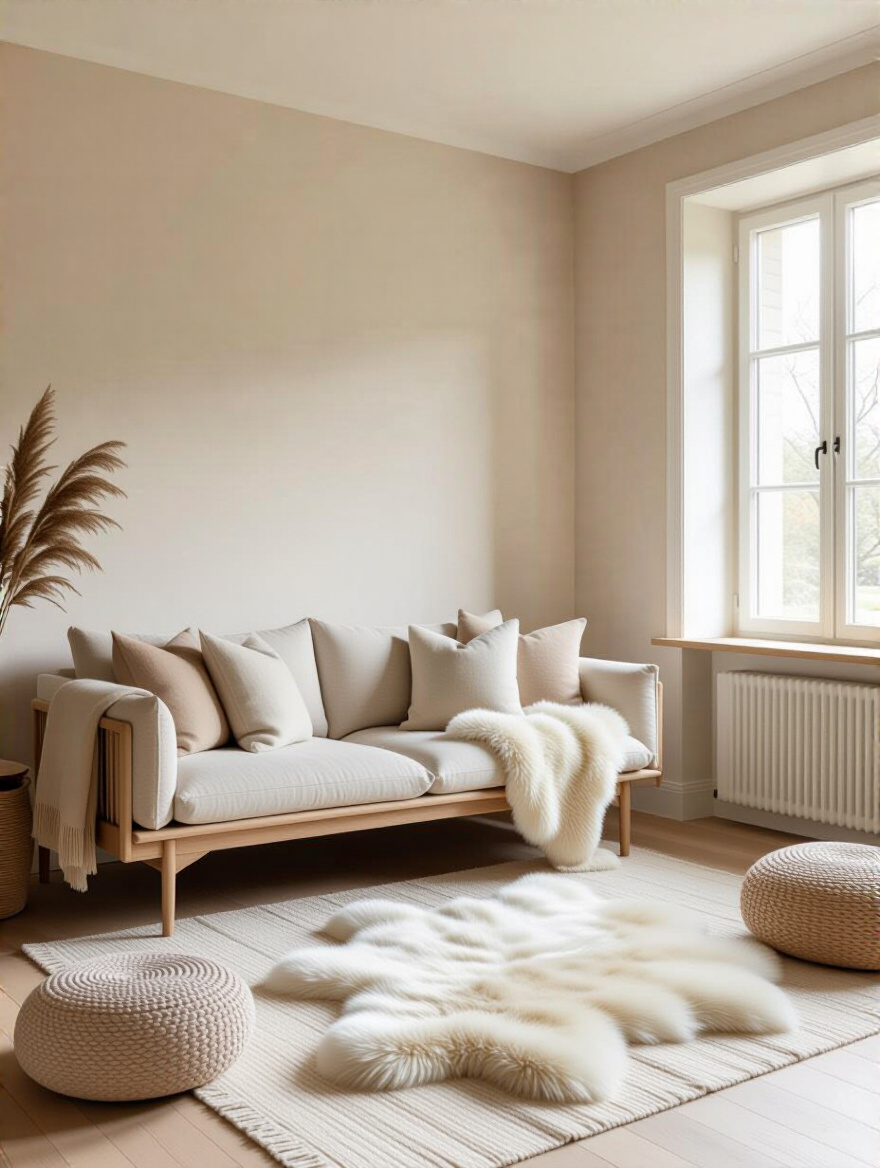
This doesn’t mean everything has to be beige. You can choose a calming family of blues and greens, or warm, earthy terracottas. The key is cohesion. When your largest pieces—your walls, your sofa, your rug—speak a similar color language, the room feels whole and intentional. This visual harmony is incredibly restorative and makes a small space feel less broken up and much more expansive.
Once your space feels harmonious, you can create a single point of focus to ground it all.
7. Embrace Single Focus: Provide a Meditative Anchor for the Eye
In a small space, our instinct is often to scatter small things around to “fill” the walls. But this just creates more of that visual static I was talking about. Your eye doesn’t know where to land, so it darts around nervously, taking in everything and resting on nothing. This is the opposite of calming.
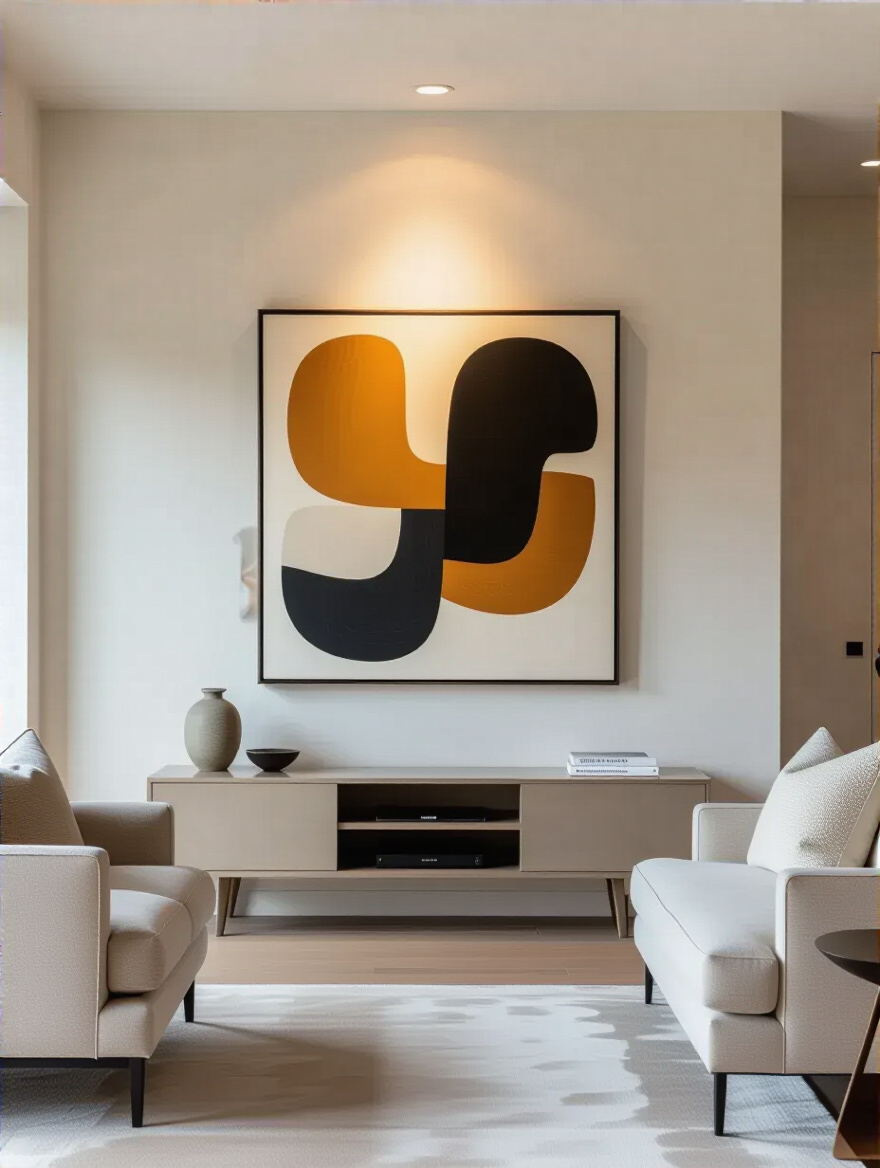
Instead, create one clear, intentional focal point. A single, large piece of art you love. A beautifully styled fireplace mantle. A window with an unobstructed view. This gives your eye a place to land and rest—a meditative anchor. By drawing all the visual energy to one spot, you allow the rest of the room to fall away into a quiet, peaceful background.
Smart Furniture Selection: Choosing Pieces That Support Your Well-being
In a sanctuary, every piece of furniture should do more than just exist; it should actively contribute to your sense of calm and well-being. This is about choosing pieces that are not just the right size, but have the right energy—light, adaptable, and intentional.
8. Choose Right-Sized Furniture: Honor Proportion Over a Label
The biggest BS in the design world is the concept of “apartment-sized” furniture. I’ve seen tiny sofas with huge, bulky arms that take up more visual space than a larger, sleeker couch. The label means nothing. What matters is proportion and visual weight. A piece should feel balanced in the room, not like it’s screaming for attention or cowering in a corner.
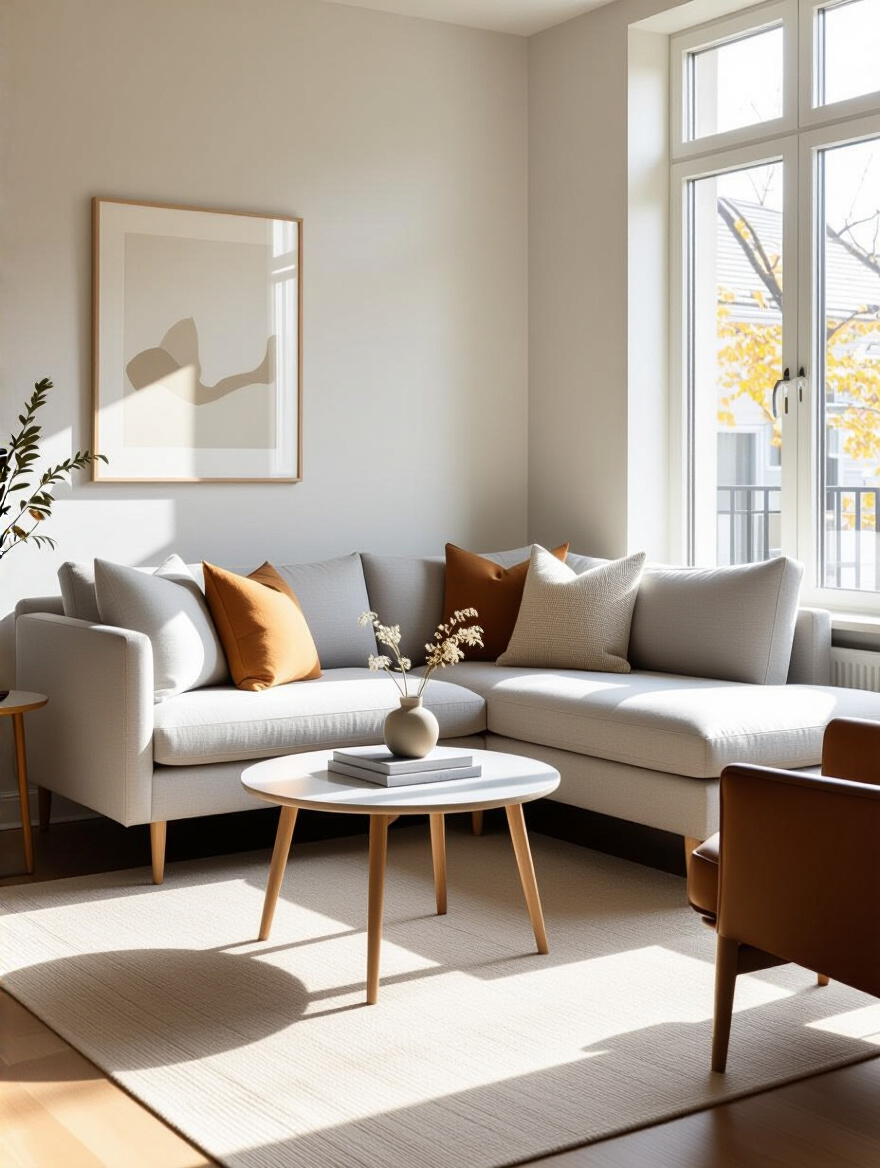
Before you buy anything, use painter’s tape to mark the footprint of a potential piece on your floor. Live with that tape for a few days. How does it feel to walk around it? Does it block a pathway? Does it feel oppressive? Trust your feeling over a dimension on a website. Sometimes, one larger, well-proportioned piece feels far calmer than several small, busy ones.
The arms of your seating can make or break this feeling of openness.
9. Opt for Armless or Slim-Arm Seating: Create an Open Invitation
Think of bulky sofa arms as visual stop signs. They create a hard boundary and add significant visual weight. A sofa with very slim arms, or no arms at all, feels more like an open invitation. It’s less formal, more communal, and creates a sense of uninterrupted flow.
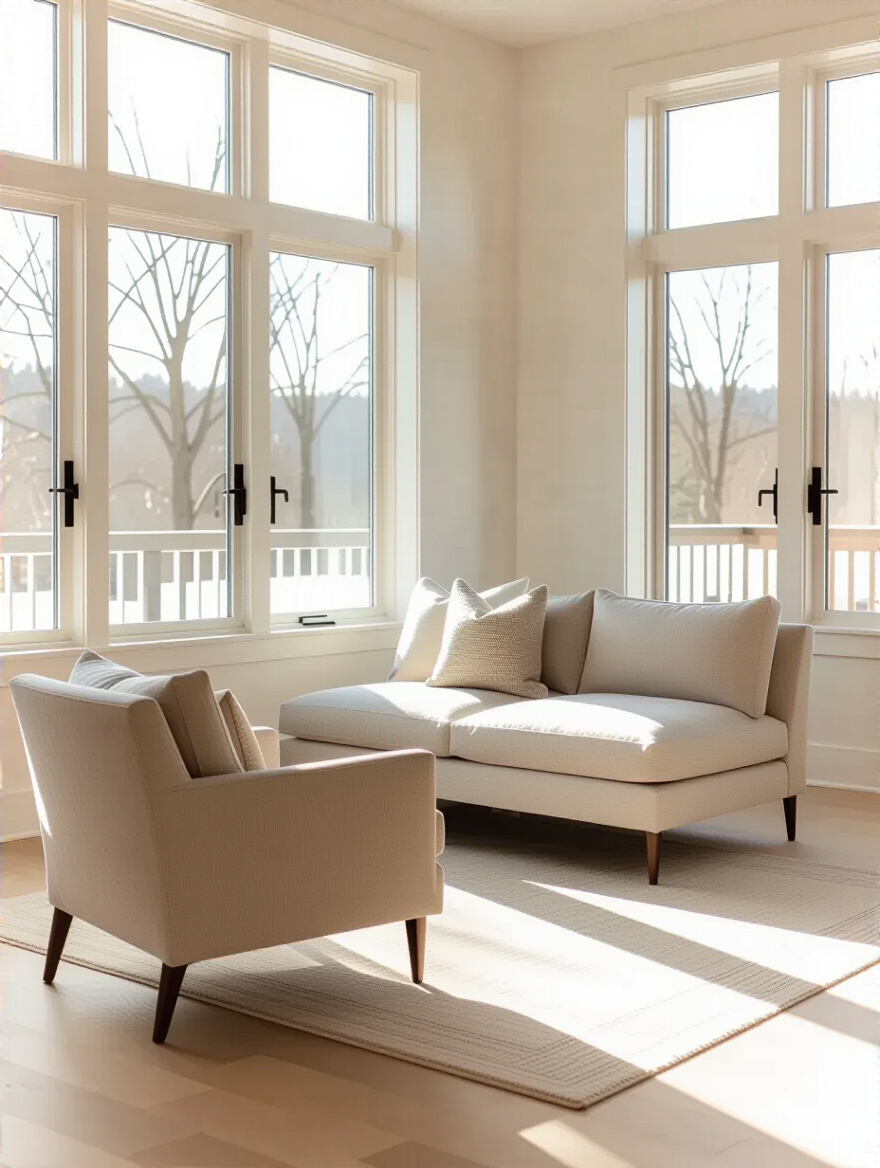
This simple switch can physically save you up to a foot of space, but the psychological impact is even greater. An armless piece breaks down barriers. It feels more integrated into the room, rather than being a fortress of seating. This contributes to a softer, more welcoming, and more expansive feeling, which is exactly what we want in our sanctuary.
Beyond form, let’s look at how furniture can serve you on a deeper level.
10. Integrate Multipurpose Furniture: Embrace Intentional Living
Multipurpose furniture isn’t just a clever space-saving hack; it’s an act of deep intention. An ottoman that stores your softest blankets or a coffee table with a lift-top that reveals a space for your books isn’t just functional. It’s a way of honoring both beauty and purpose, of giving everything a home so your mind doesn’t have to carry the burden of clutter.

When you select pieces that serve multiple needs, you are curating your space with mindfulness. You need fewer things overall, which is the ultimate luxury in a small space. This thoughtful consolidation of function creates a powerful sense of order and calm, allowing the room to adapt to your life without ever feeling chaotic.
This adaptability can be found in even the smallest tables.
11. Select Nested or Stacking Tables: Let Your Space Breathe With You
I love nesting tables because they feel like they can breathe with your life. On a quiet evening, they are a single, compact unit, preserving that precious open space for calm. But when friends come over and you need more surfaces for cups of tea, they expand to meet the moment, effortlessly creating connection and ease.
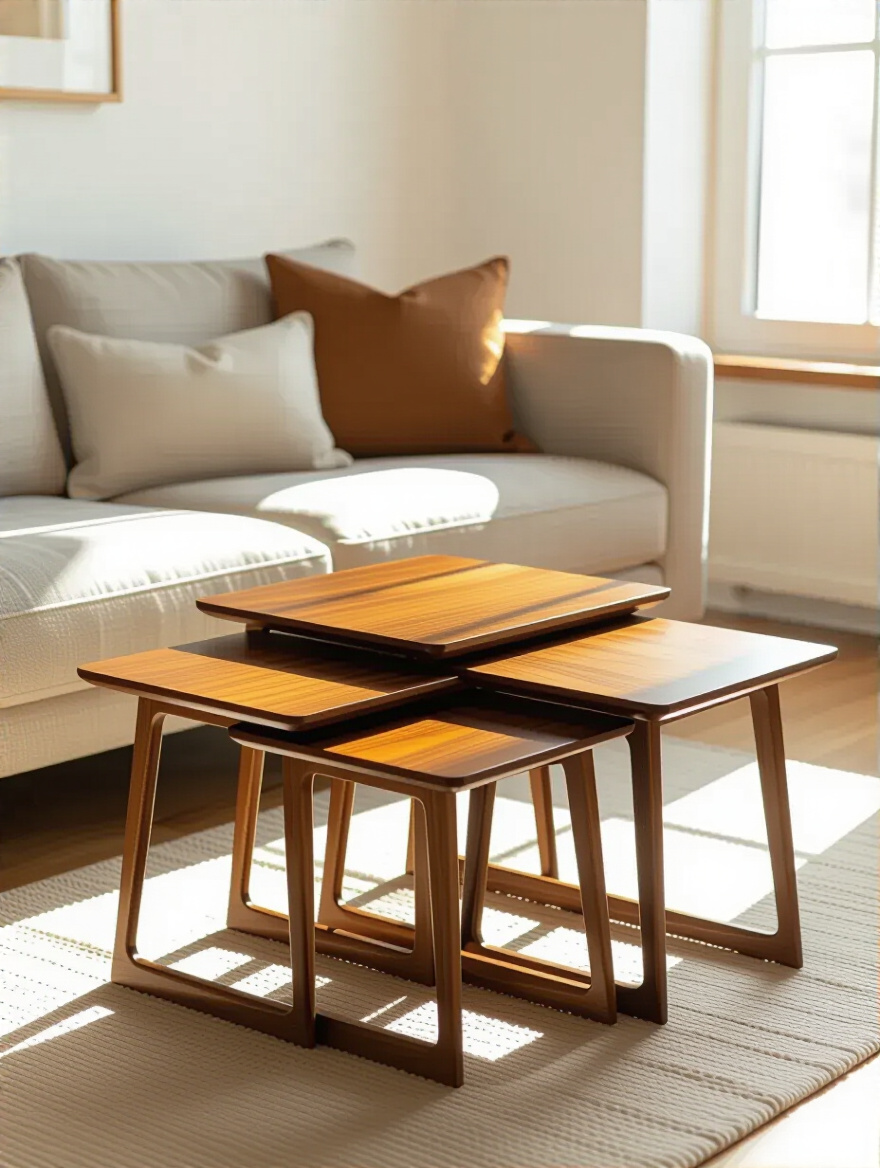
This kind of flexibility is a gift in a small home. It allows your space to be responsive to your needs without the permanence of multiple, fixed tables. This fluid adaptability—the ability to expand for community and contract for solitude—is the essence of a sanctuary that truly serves you.
Similarly, other seating options can offer this same beautiful flexibility.
12. Consider Backless Benches or Ottomans: Keep the Energy Flowing
Like furniture with raised legs, backless pieces like benches or ottomans are all about maintaining flow. A piece without a back doesn’t create a visual barrier. It doesn’t block light or your sightline, allowing the room’s energy to move freely and making the whole space feel more connected and open.
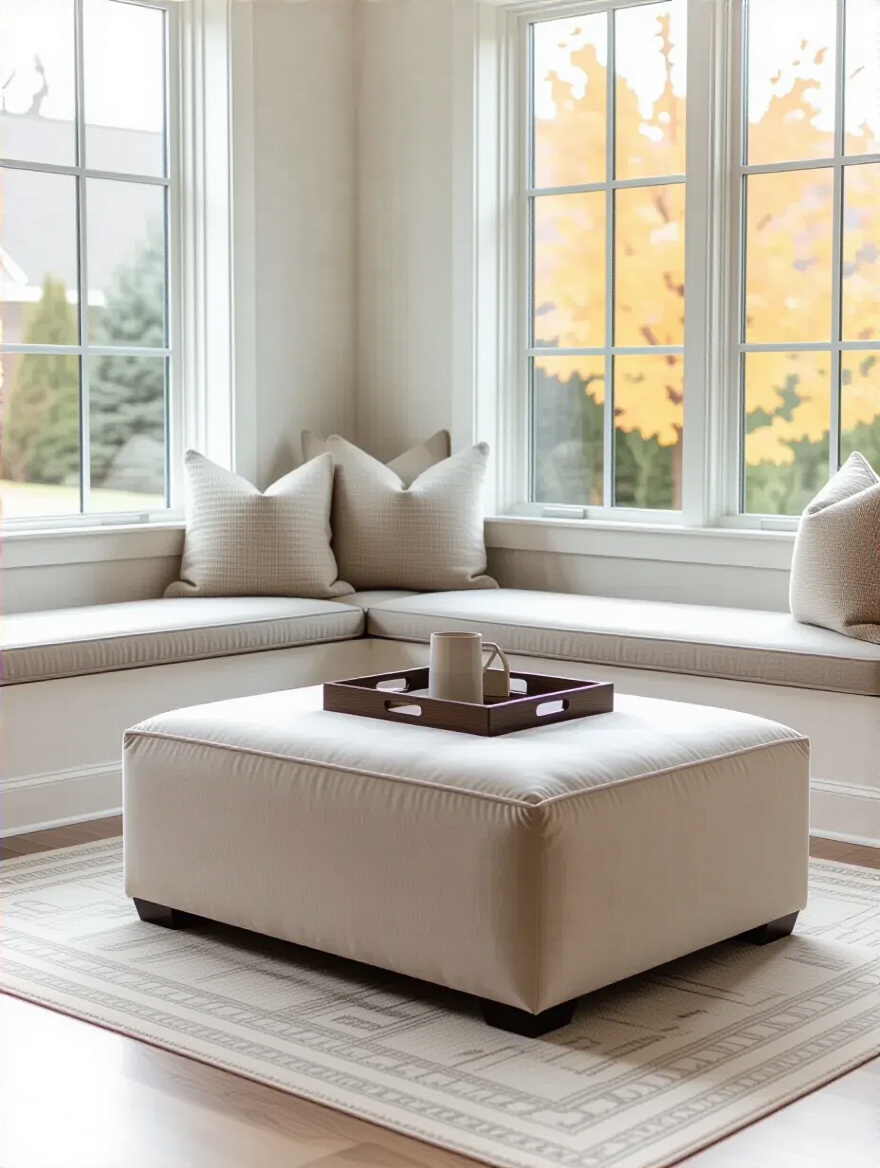
Their versatility is their calming power. An ottoman can be a footrest, a coffee table (with a tray on top), or extra seating in a single breath. This adaptability means you don’t need more stuff. One beautiful, soft piece can play all these roles, moving and changing as you need it to, keeping your sanctuary feeling fluid and uncluttered.
And for the ultimate in low-impact furniture, some pieces can almost disappear entirely.
13. Use Transparent Furniture: The Beauty of Quiet Function
Acrylic or glass furniture is the physical embodiment of quiet service. A clear coffee table or console offers you its function—a surface to place your cup or a book—without demanding any visual attention. It does its job and then recedes into the background, allowing the beauty of your rug or the feeling of open space to be the star.
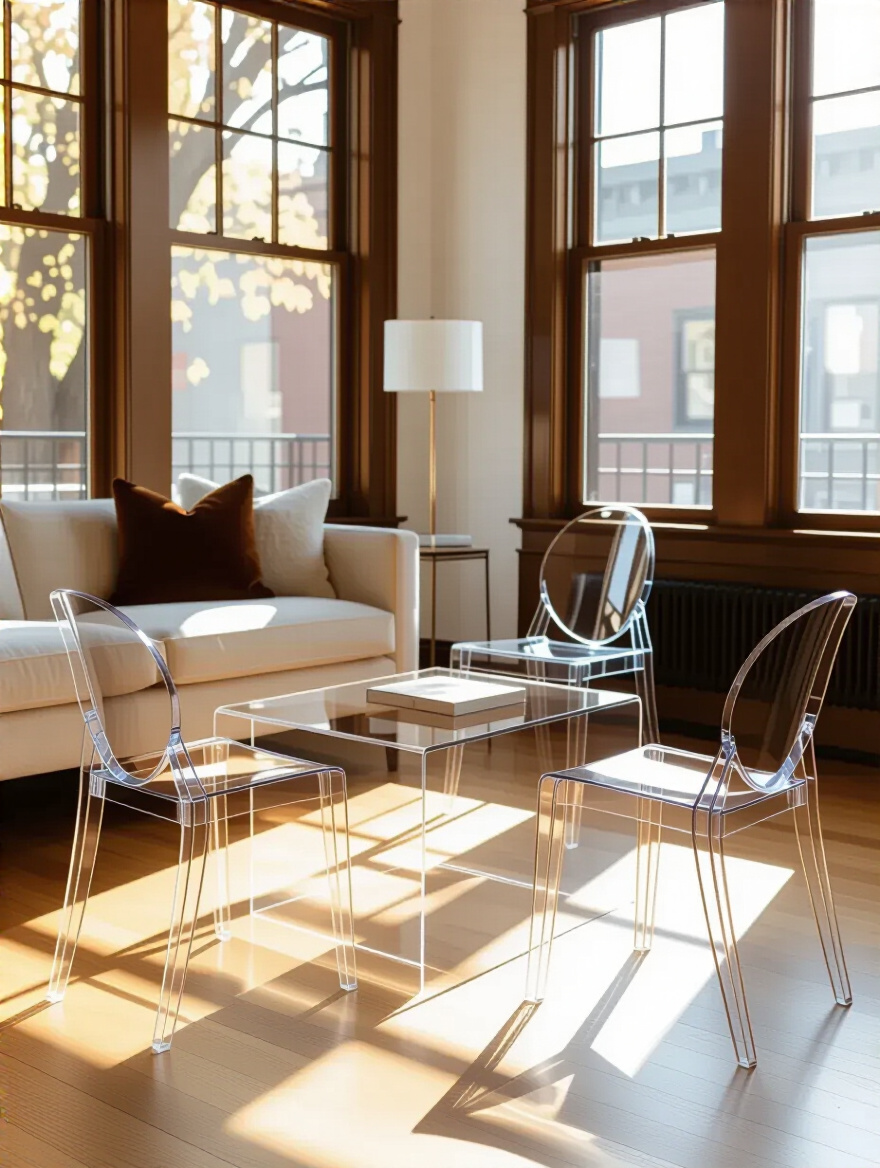
I call these “ghost” pieces. They allow light to pass through them and don’t interrupt your sightline, which is a powerful way to reduce visual weight. In a small sanctuary, having pieces that serve you without taking up visual real estate is a profound relief for the senses, helping the entire room feel calmer and clearer.
Clever Storage Solutions: Creating Calm by Containing Chaos
True serenity in a small space isn’t about having less; it’s about giving everything you own a peaceful, intentional home. Storage isn’t about hiding things away in shame. It’s a respectful act of creating order, which directly calms the mind and allows you to live with only the things you need in the moment.
14. Implement Vertical Storage Solutions: Draw the Eye and Spirit Upward
When we feel confined, our energy tends to feel low and heavy. Drawing the eye upward is an act of release and aspiration. Floor-to-ceiling shelving does just that. It leverages the most under-utilized real estate in your home—your walls—to create abundant storage while simultaneously making the room feel taller and more expansive.
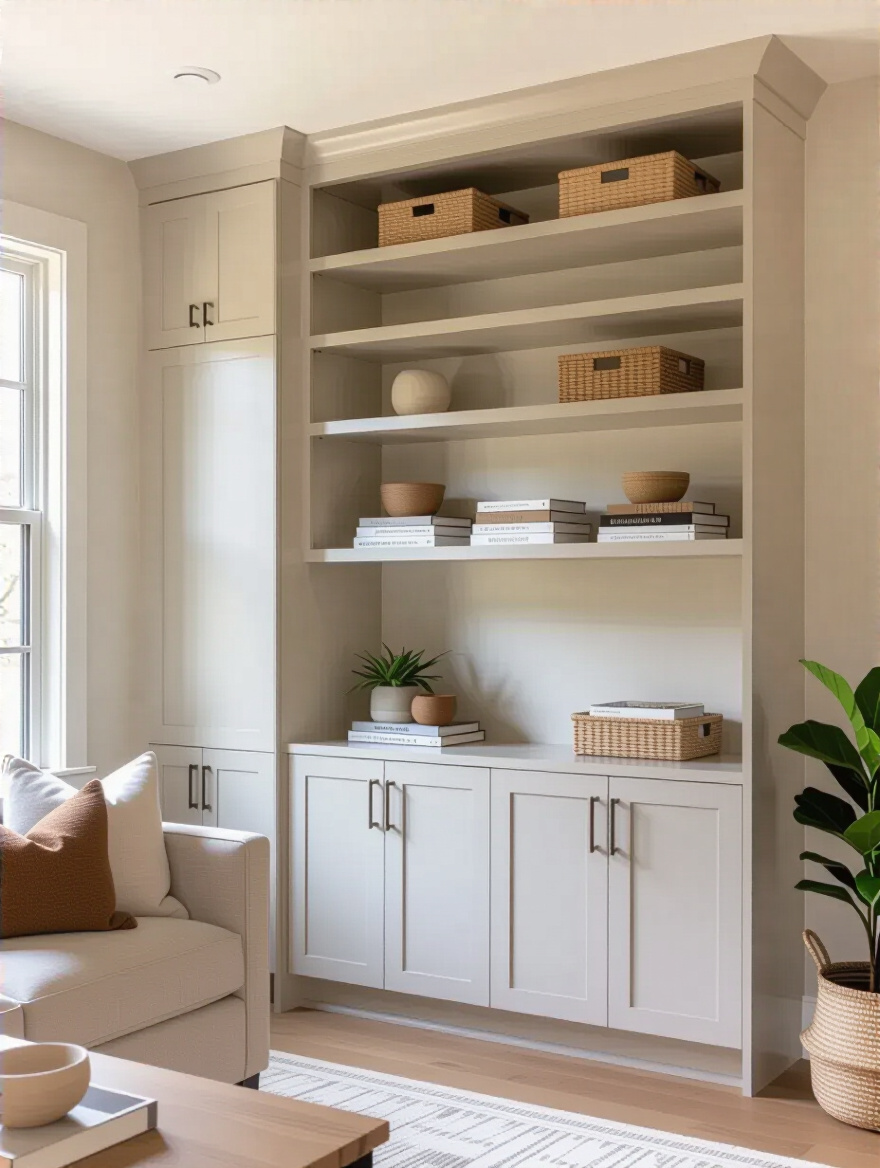
Think of it as creating a library of your life that stretches towards the sky. By going vertical, you free up invaluable floor space, which is essential for that feeling of open flow. Painting the shelves the same calm color as the walls allows them to blend in, creating a seamless, integrated look that feels like a quiet, architectural hug rather than a bulky piece of furniture.
As you look up, don’t forget the hidden potential right at your feet.
15. Incorporate Under-Furniture Storage: Create Secret Sanctuaries for Your Things
The space under your sofa or bed doesn’t have to be a dust bunny graveyard. It can be a secret, soft-closing sanctuary for the things you don’t need every day—extra blankets, seasonal pillows, or old photo albums. Using low-profile wheeled bins or custom drawers transforms this dead space into quiet, intentional storage.
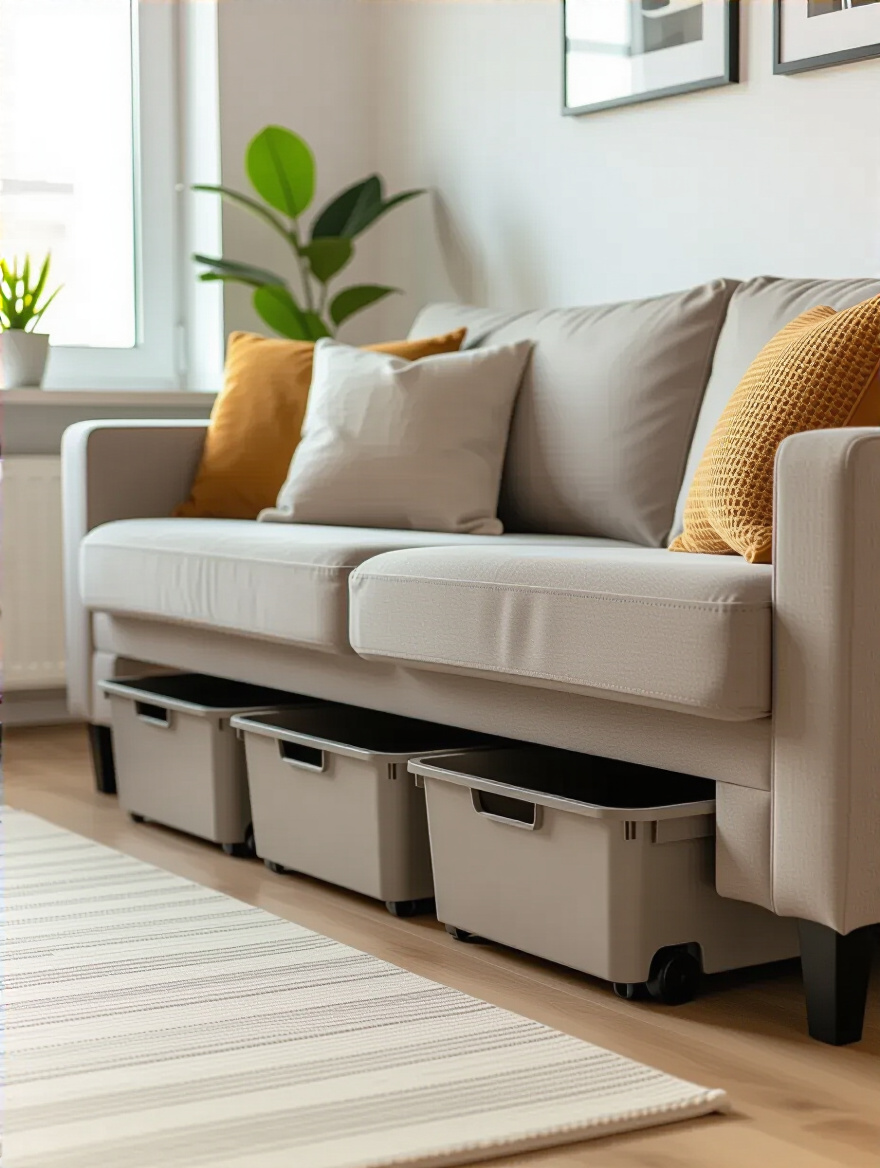
There’s a deep psychological comfort in knowing everything has a place. By tucking these items away, you are protecting your mind from the low-grade chaos of seeing them out of place. It’s a way of honoring your belongings while fiercely protecting your own peace of mind and your precious visual space.
The heart of your room, the coffee table, can be one of the hardest-working storage heroes.
16. Select Storage-Optimized Coffee Tables: Calm the Core of Your Room
The coffee table is often the epicenter of living room clutter—remotes, coasters, magazines, charging cables. A table with Built-in Storage is a quiet hero. A lift-top that reveals a hidden compartment or a set of deep drawers can instantly swallow this daily chaos, restoring a sense of calm to the very heart of your sanctuary.
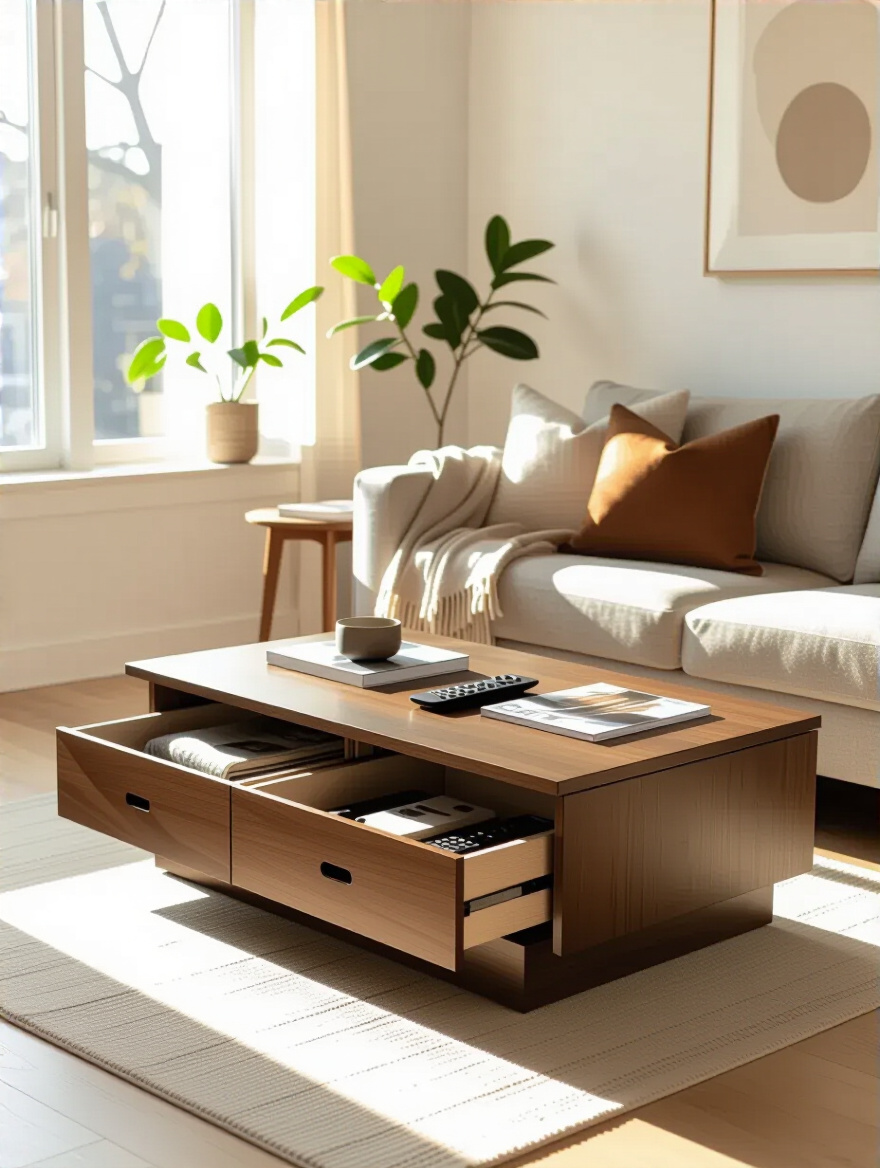
By keeping this central surface clear, you give your entire room an anchor of order. The relief of being able to put everything away at the end of the day into one simple, beautiful piece is immense. It allows the room to reset, and you along with it, creating a clean slate for relaxation.
For the most seamless calm, storage can become part of the room itself.
17. Integrate Built-In Shelving: The Ultimate Expression of Harmony
Built-in shelving that’s designed for an awkward nook or around a fireplace is the ultimate expression of harmony between your home and your belongings. It feels like the house itself is holding and organizing your things. Because it becomes part of the architecture, it adds immense function without adding any bulky furniture.
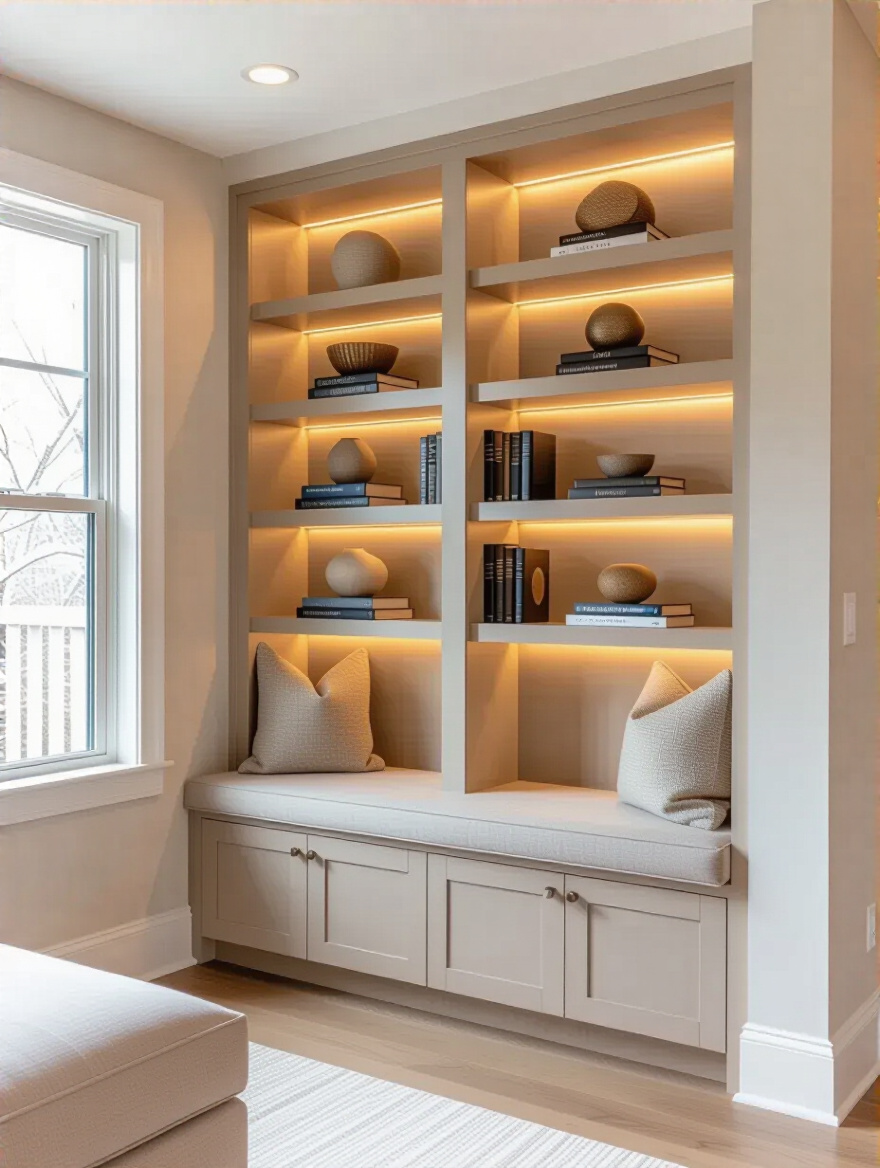
This seamlessness is profoundly calming. There are no gaps behind it collecting dust, no sense of it being a separate object. It simply is. This kind of integrated storage makes a room feel custom, thoughtful, and incredibly serene, turning a previously wasted space into a feature of beautiful order.
Finally, for the little things, we can use nature’s own containers.
18. Organize with Stylish Baskets & Bins: Contain Chaos with Natural Texture
For the clutter of daily life—the throw blanket you use every night, the kids’ toys, the dog’s favorite chew toy—beautiful baskets are a perfect solution. They contain the chaos, but they do it with softness and warmth. A woven seagrass basket or a soft felt bin adds a layer of natural texture that is grounding and pleasing to the touch.
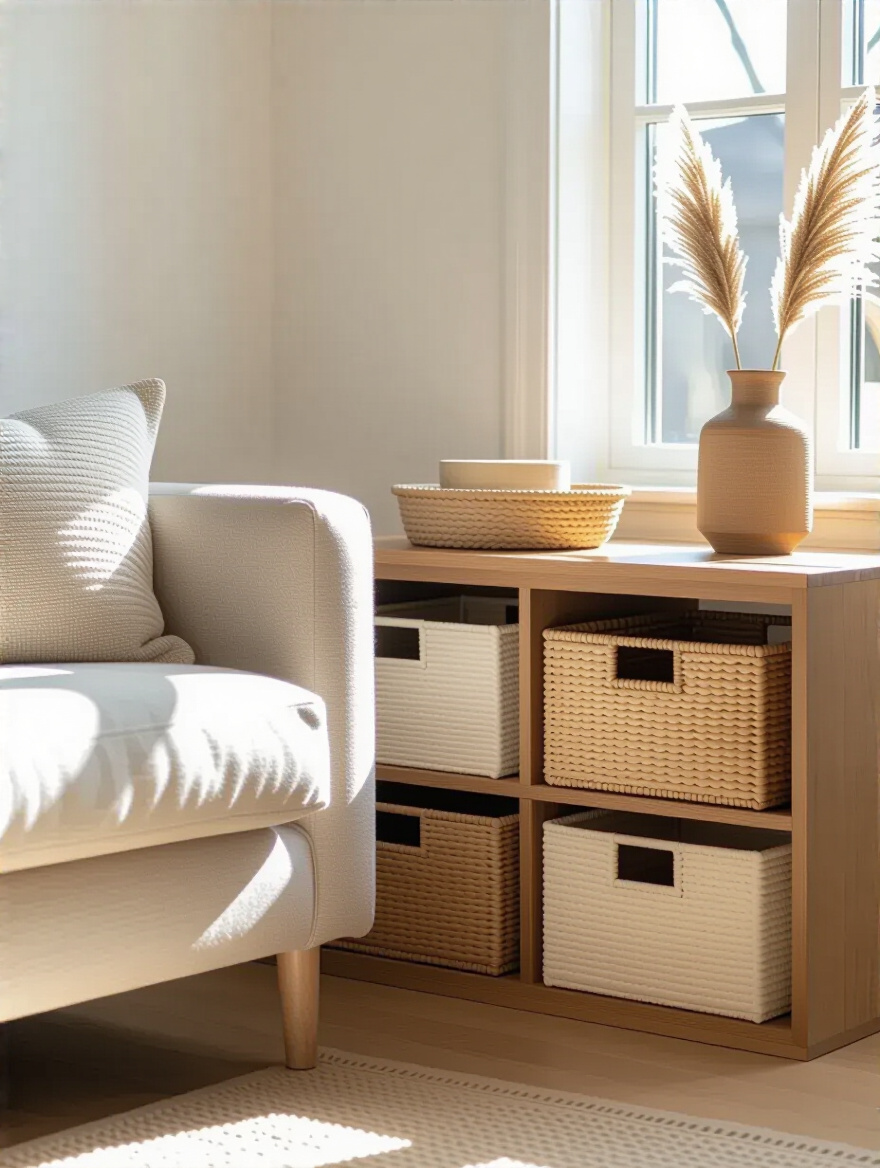
Think of them as soft nests for your things. They offer a quick and easy way to tidy up, creating instant visual calm. Instead of a pile of ‘stuff,’ you have a beautiful, textural object that adds to the room’s serene aesthetic. It’s a way of making organization itself an act of beauty.
Lighting & Decor Tricks: Curating the Soul of Your Space
With the foundations of flow and order in place, we can now add the layers that give a sanctuary its soul. Lighting and decor are not afterthoughts; they are the tools we use to craft a specific mood, to create a feeling of warmth, and to deepen the sense of restorative peace.
19. Layer Lighting Sources: Bathe Your Room in a Soft Glow
A single, harsh overhead light is the enemy of calm. It flattens a room and feels aggressive to the senses. Instead, think of lighting your sanctuary like you’re creating a sound bath. You need different notes and tones to create a rich, immersive experience. Layering light—ambient, task, and accent—allows you to do just that.
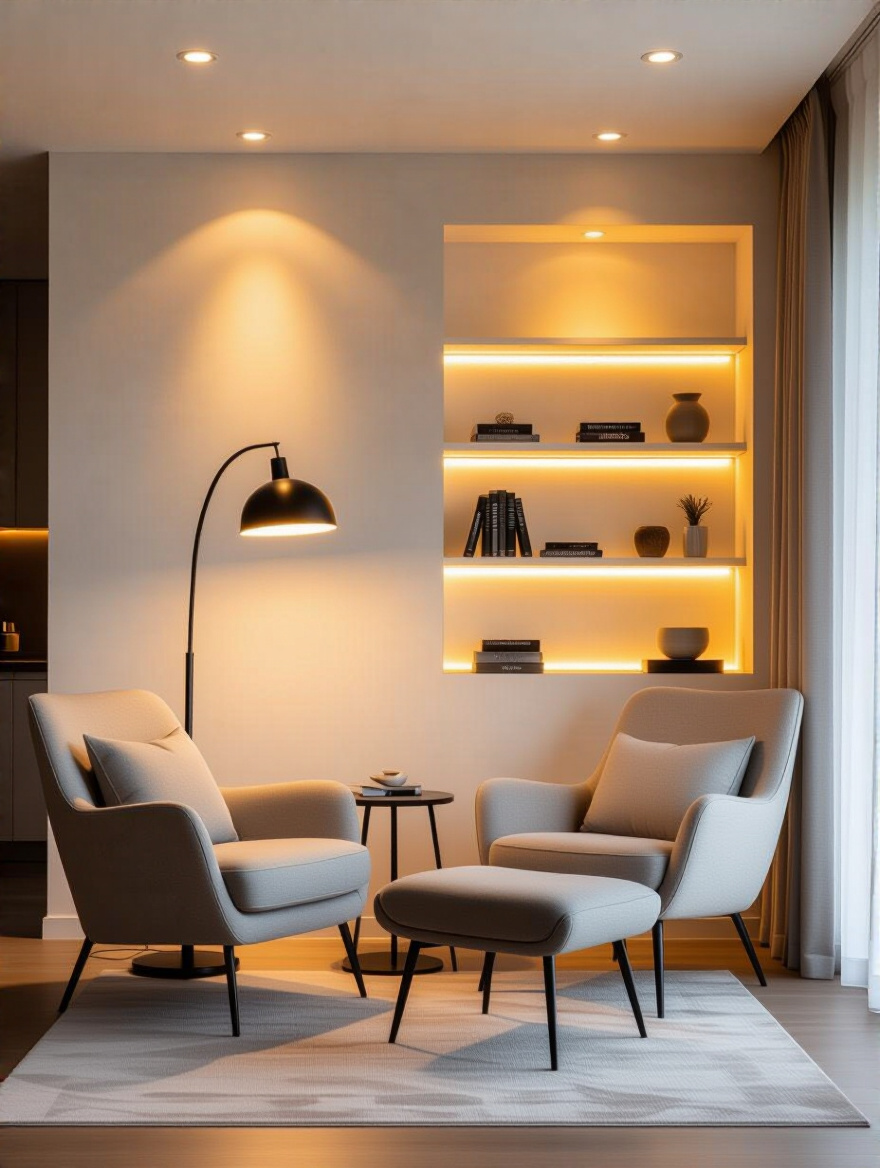
Use a soft overhead light on a dimmer for general (ambient) glow. Add a beautiful floor lamp by a chair for reading (task). And use a small, warm lamp on a console or a picture light to create a soft pool of light in a corner (accent). This combination creates depth, warmth, and dimension, making your small room feel enchanting and alive. Most importantly, it gives you the control to adjust the mood to match your own.
How you treat your windows has a huge impact on the quality of this light.
20. Choose Sheer Window Treatments: Let Your Windows Breathe
Heavy, opaque drapes can make a small room feel like it’s holding its breath. Sheer window treatments, on the other hand, allow your sanctuary to exhale. They soften and diffuse natural light, bathing your room in a gentle, restorative glow while still providing a sense of privacy and separation from the outside world.

Hanging them high, near the ceiling, and wide, beyond the window frame, creates a beautiful illusion of height and space. But the real magic is in the feeling. The soft fabric adds a layer of texture without any visual weight, creating a dreamy, ethereal quality that is the essence of a peaceful retreat.
Once your light is soft, give your eye one beautiful thing to focus on.
21. Use One Oversized Piece of Art: Create a Window for Your Soul
Forget busy gallery walls in a small space; they often just become more visual chatter. The most powerful way to create a focal point in a sanctuary is with a single, large piece of art that you have a deep, personal connection to. Think of it as creating a window for your soul.
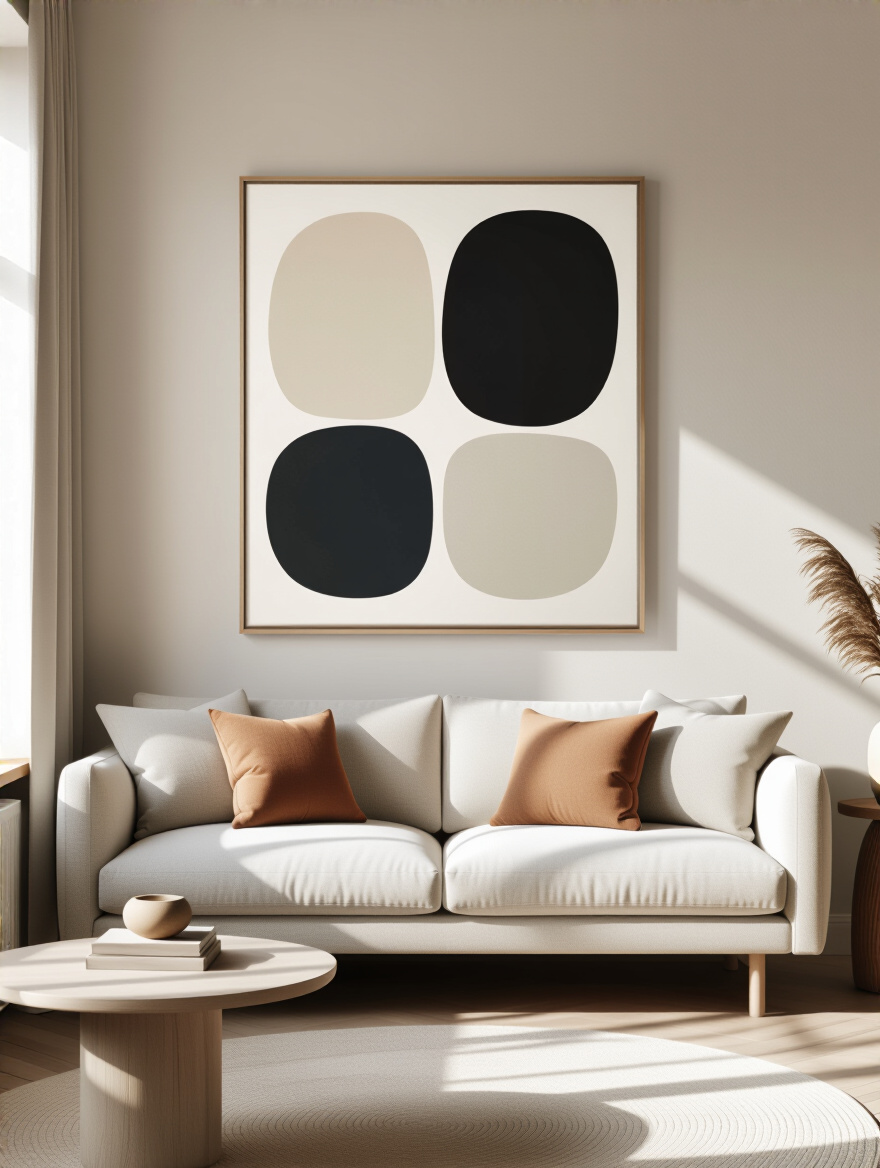
A large piece grounds the space and gives your mind a single, beautiful place to rest. It shows confidence and intention. By focusing the room’s decorative energy in one impactful statement, you allow the rest of the space to be quiet. This singular focus is incredibly calming and can make the whole room feel more expansive and purposeful.
To define the sacred ground within your room, turn to a rug.
22. Define Zones with Area Rugs: Create an Island of Intention
An area rug is so much more than a floor covering. In a small living room, it’s a way of drawing a boundary and creating a “sacred space.” When you place a rug under your seating area, you’re creating a defined zone for rest and connection. It’s an island of intention in the middle of your home.
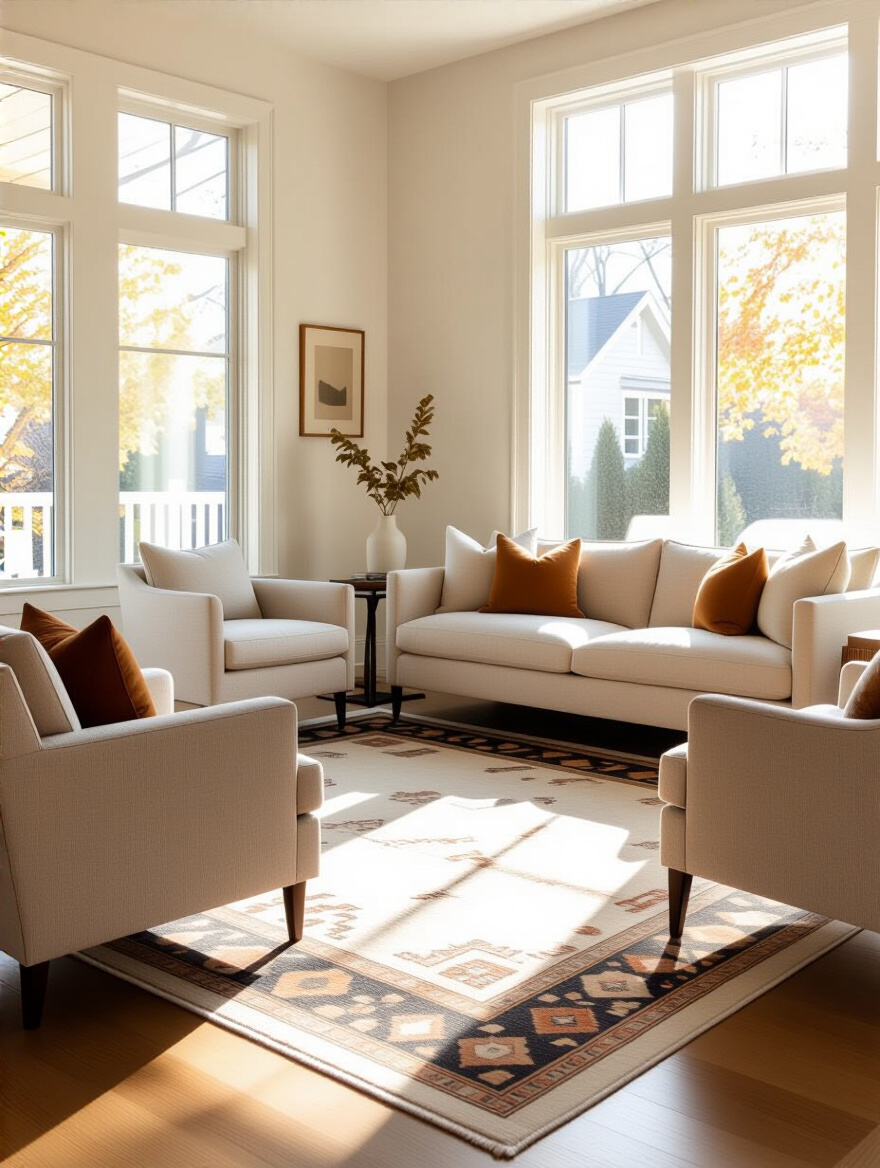
The rule is to make sure it’s large enough for at least the front legs of your main seating to rest on it. This visually grounds the furniture, making the arrangement feel cohesive and intentional, not like a collection of random pieces floating in space. This sense of being grounded is deeply reassuring and makes your living area feel like a dedicated haven.
Finally, bring actual, living energy into your sanctuary.
23. Add Greenery with Strategic Plants: Breathe Life into Your Haven
No sanctuary is complete without a touch of living nature. Plants are not decor; they are life. They literally breathe with you, purifying your air and bringing a vibrant, healing energy into your space. Their presence is scientifically proven to lower stress and create a sense of well-being.
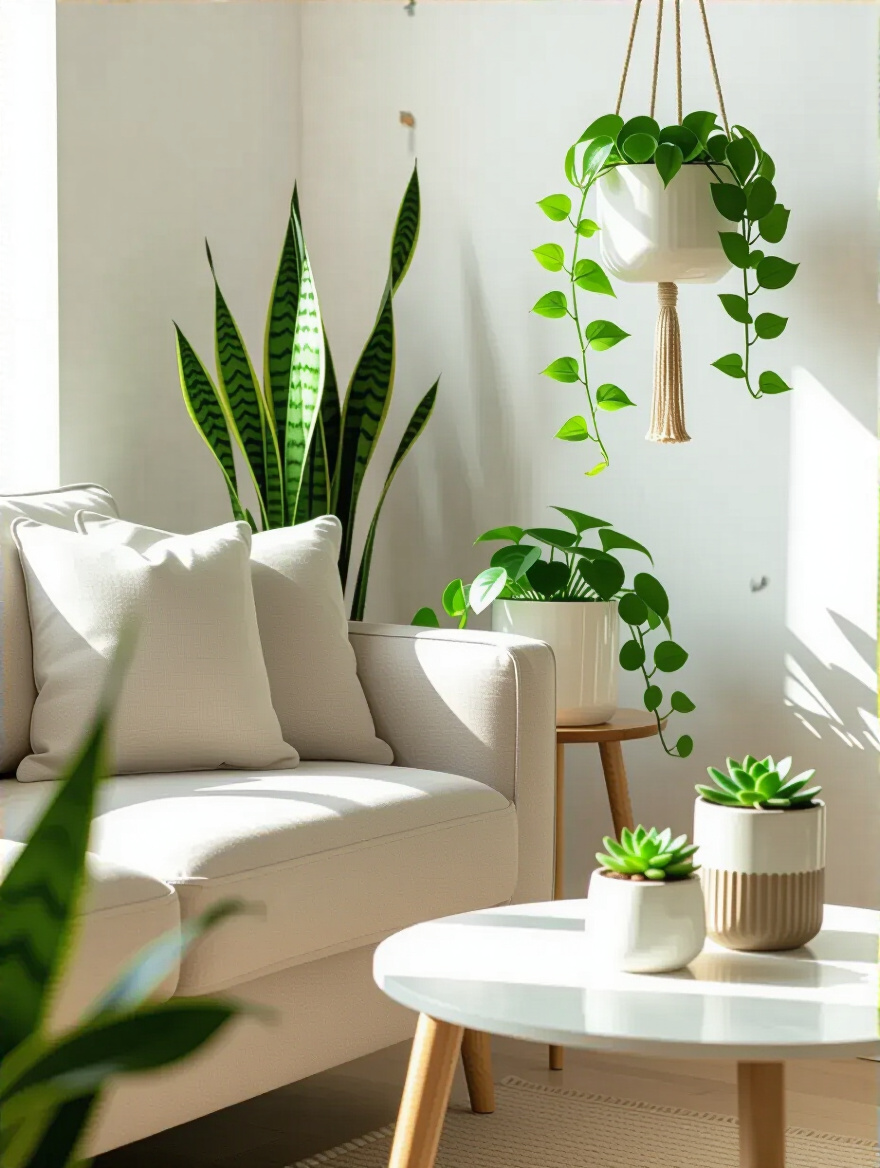
In a small space, go vertical. A tall, slender snake plant in a corner, or a vining pothos trailing from a high shelf, draws the eye upward and adds lushness without taking up precious floor space. Just a few strategically placed plants can transform the feel of a room, making it feel more alive, healthier, and deeply connected to the natural world.
Conclusion: Your Sanctuary Awaits
As you can see, creating a restful living room has very little to do with its actual size and everything to do with intention. It’s about clearing away the visual noise so your mind can quiet down. It’s about creating effortless flow so your body can feel at ease. And it’s about choosing pieces that don’t just fill space, but actively support your well-being.
Don’t try to do all of this at once. Start with one thing that resonated with you. Maybe it’s clearing every surface for a weekend to see how it feels. Or maybe it’s finding one beautiful basket to contain the remote controls and blankets. Your home should be the one place in the world that restores your energy, not drains it. By making these thoughtful choices, you can transform even the smallest living room into a true sanctuary—a space that holds you, calms you, and welcomes you home to yourself.
